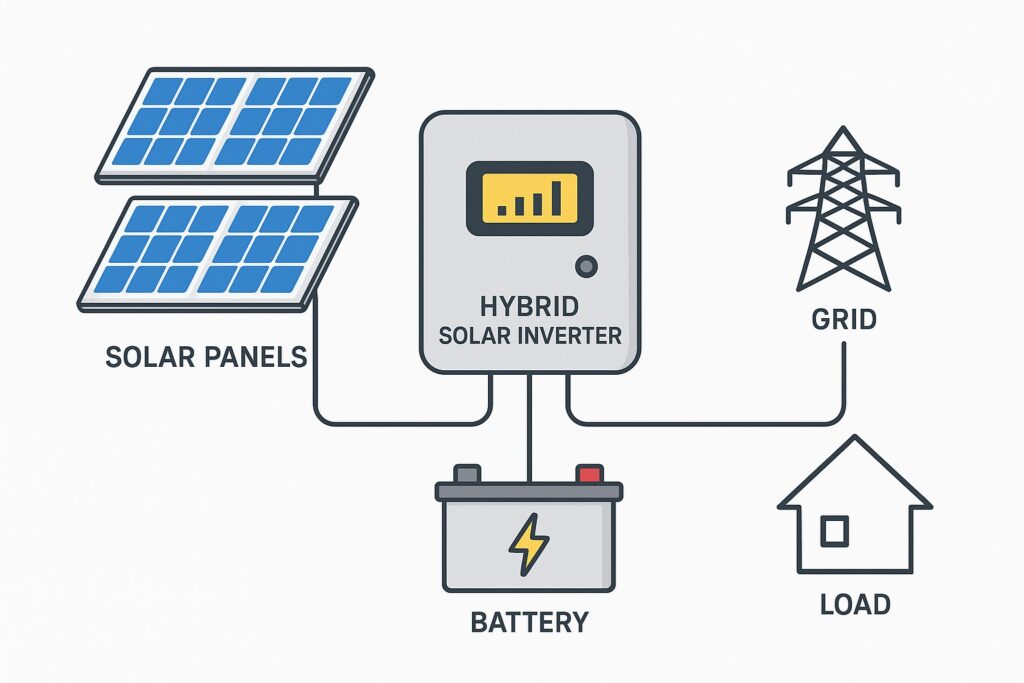1) What is a hybrid solar system?
A hybrid solar system is a PV installation that operates both connected to the grid and with on-site battery storage. During sunny hours the array powers loads and charges batteries; at night or during outages the battery supplies critical loads. Hybrid systems combine the lower cost of grid-tied installations with the resilience of off-grid systems, and they offer smart energy management features such as time-of-use optimisation and peak-shaving.
2) Core components and how they work
- Solar panels (PV array): produce DC electricity from sunlight.
- Hybrid inverter / inverter-charge controller: converts PV DC to AC for your home, charges/discharges the battery and coordinates grid interaction. Modern hybrid inverters handle energy routing, grid synchronization and prioritisation of loads.
- Battery bank (lithium-ion or lead-acid): stores excess PV for later use or outages.
- Metering & protection gear: distribution board, breakers, isolators and sometimes export-limiting devices.
- Monitoring system: lets you view production, consumption and battery state-of-charge.
Most hybrid inverters are all-in-one units with inputs for PV, battery and grid — simplifying installation and control.
3) Why panel choice matters for hybrid setups
In a hybrid system the panels don’t just feed immediate loads — they also charge batteries and define how quickly you can store daytime energy. Two real constraints make panel choice important:
- Roof / space availability: Higher-efficiency panels generate more power per square metre, which is valuable when roof area is limited.
- System economics & longevity: Panels with lower degradation and longer warranties reduce long-term cost per kWh stored and used.
So when you ask “what is the best type of solar panel for a hybrid system?” think in terms of efficiency, warranty, temperature performance and real-world degradation — not just headline watt numbers.

4) Comparing panel types
- Monocrystalline (mono): Highest efficiency in mainstream PV (often >20% in modern modules), best for limited roof area, good low-light and temperature response, commonly paired with residential hybrid systems. Lifespans commonly 25+ years with low degradation.
- Polycrystalline (multi): Slightly lower efficiency and lower cost. best type of solar panel value where roof space is abundant. Performance and warranties are solid but not class-leading.
- Thin-film (CdTe, CIGS): Lower efficiency, lighter and sometimes better at high temperatures or diffuse light. Rare for residential rooftop hybrid systems unless weight or flexibility is the priority.
- Advanced cell tech (PERC, bifacial, all-back-contact, heterojunction): These are enhancements or specialty modules that can push efficiency and performance metrics higher. Bifacial can add yield if rear-side reflection is present; PERC improves efficiency and low-light output.
5) Picking the best type of solar panel for common scenarios
A — Small rooftop, want maximum storage & uptime (typical hybrid homeowner):
Best choice — monocrystalline high-efficiency panels (plus PERC or heterojunction variants if budget allows). They give the most power per m² so batteries get charged faster and you maximise self-consumption.
B — Large roof or ground-mount, budget-conscious:
Consider high-watt polycrystalline or lower-cost mono modules with a larger array. If you have spare area, slightly lower efficiency panels still work well because you can install more panels.
C — Harsh rooftop temperature / coastal environment (Goa example):
Choose panels with strong temperature coefficient ratings and good corrosion resistance. Monocrystalline modules with reputable silicone encapsulation and robust frame coatings are common picks. Check the vendor’s salt-mist and PID (potential-induced degradation) resistance tests.
D — Looking for highest lifetime value and brand support:
Top-tier manufacturers (identified in independent rankings) combine efficiency, warranty and low degradation rates; these often translate to better long-term performance for hybrid systems.
6) Example solar panel setup options
All samples assume a hybrid inverter with battery and export-limiting capability.
- Compact hybrid — 3.5 kW mono array (roof), 5 kWh Li-ion battery, 3 kW hybrid inverter. Good for small households wanting 4–6 hours of essential backup.
- Balanced hybrid — 6 kW mono array, 10 kWh battery, 5 kW hybrid inverter. Suitable for families with medium consumption and partial daytime self-consumption.
- High-autonomy hybrid — 10 kW+ array, 15–20 kWh battery, 8–10 kW inverter (three-phase if needed). For large homes or small commercial installations.
When specifying modules, prefer panels with 25-year performance warranties and an annual degradation ≤0.5% for best lifetime energy yield.
7) Installation & permitting notes
- Check state/net-metering rules and hybrid inverter approval for export-limited configurations.
- In Goa, coastal installations should use corrosion-resistant mounting and ensure panel frames have proper grounding.
- Choose an installer who will size the array, battery and inverter together — mismatched component sizing is the most common performance issue.
- Confirm warranty handling (local service centre) and ask if the vendor offers performance guarantees.
8) Helpful enhancements, monitoring and maintenance
- Smart energy management: Time-of-use charging/discharging saves more where tariffs vary. Hybrid inverters often support scheduled battery charging.
- Monitoring platform: Remote monitoring helps spot underperformance and reduce downtime.
- Surge & lightning protection: Essential in coastal and tropical climates.
- Maintenance: Clean panels seasonally (dust, bird droppings). Annual electrical checks for cabling, isolators and battery health.
9) Author & review box
Author: Senior Renewable Energy Engineer — 10 years’ experience designing residential and small-commercial hybrid PV systems. I design hybrid systems focusing on real-world use (limited roof area, variable tariffs, grid reliability).
Reviewed by: Technical reviewer from Xnergs — system sizing, inverter selection and installation best practices verified.
Business details (Xnergs)
Xnergs — Near O, Coquerio Circle, Chogam Road, Porvorim, Goa
Phone: +91-8908905556 · Email: info@xnergs.in · Website: xnergs.in
10) FAQ
Q: Is monocrystalline always the best?
Q: How many panels do I need to charge a 10 kWh battery in a day?
Closing
If you want a no-obligation site survey and a tailored hybrid proposal that prioritises the best type of solar panel for your roof and budget, Xnergs can help — call +91-8908905556 or email info@xnergs.in. We’ll size the PV, battery, and inverter to meet your reliability and ROI goals.
